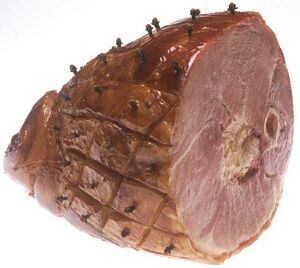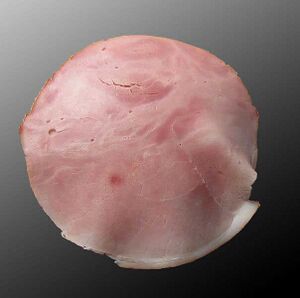-
Ham
-
Spanish Jamon serrano of Huelva
-
Sliced ham
Ham is the thigh and rump of pork, cut from the haunch of a pig or boar. Although it may be cooked and served fresh, most ham is cured in some fashion. Cuts referred to as 'ham' in the US are called 'gammon' in the UK and Ireland.
Ham can be dry cured or wet-cured. A dry-cured ham has been rubbed in a mixture containing salt and a variety of other ingredients (usually various proportions of sodium nitrate and sodium nitrite). This is followed by a period of drying and ageing. dry cured hams may require a period of rehydration prior to consumption. A wet-cured ham has been cured with brine, either by immersion or injection. The distinction between wet and dry cure is not always clear cut as some ham curing methods begin wet but are followed by dry ageing.
dry cured varieties include Italian prosciutto (prosciutto di Parma, prosciutto di San Daniele, prosciutto di Carpegna, prosciutto di Modena, prosciutto Toscano, prosciutto Veneto Berico-Euganeo, Valle d’Aosta Jambon de Bosses, prosciutto di Norcia) and the Spanish jamon serrano and jamón ibérico. The United States has country ham (including Virginia ham), which might or might not be smoked. England has York ham. Germany's Westphalian ham is usually smoked over juniper, in Belgium there is the smoked Ardennes ham, and from China there is the un smoked Jinhua ham. In Bulgaria, the specific Elenski but is produced. From Iran, we get the dry cured Zard Kūh ham.
Ham is also processed into other meat products such as Spam (luncheon meat). Also, a processed form of ham is commonly sold in tins or 'cans'.
Regional use
France
Bayonne Ham or Bayonne is an air dried salted ham that takes its name from the ancient port city of Bayonne in the far South West of France (Le Pays Basque or the Basque country).
Jambon de Paris is a wet-cured, boneless ham and baked in shape. The ham is a superior quality product prepared from fresh, unfrozen pork thighs without adding polyphosphates.
Germany
- Black Forest ham, known as Schwarzwälderschinken, is from the Black Forest region of Germany. It is seasoned, dry cured, then smoked over sawdust and fir brush.
- Westphalian ham is created from pigs raised in the Westphalian Forest which feed on acorns. The resulting meat is dry cured and then smoked over a mixture of beechwood and juniper branches.
Italy
In Italy, ham is called prosciutto, and can be either raw (prosciutto crudo) or cooked (prosciutto cotto).
Parma ham, the so called Prosciutto di Parma, has almost 200 producers concentrated in the eastern part of Parma Province. Its production is regulated by a quality consortium that recognises qualifying products with a distinctive mark. Only larger fresh hams are used (12-13 kilograms). Curing uses relatively little salt, but can include garlic salt and sugar thus producing a sweeter meat. After salting, the meat is sealed with pig fat over the exposed muscle tissue which slows drying. Curing occurs over a minimum of 12 months. This curing method uses only salt, without nitrates and without spices. No conserving substances are added. San Daniele ham (Prosciutto di San Daniele) is the most similar to Parma ham, especially regarding the low quantity of salt added to the meat, and is the most prized variety. Other raw hams include the so- called "nostrani" or "nazionali" or "toscani"; they are more strongly flavoured and are produced using a higher quantity of salt.
Portugal
In Portugal, besides several varieties of wet-cured hams called fiambre (not to be confused with the Guatemalan dish, also called fiambre), the most important type of ham is presunto, a dry cured ham similar to Spanish jamón and Italian prosciutto. There is a wide variety of presuntos in Portugal; among the most famous are presunto from Chaves and presunto from Alentejo (made from the haunches of black Iberian pigs).
See also
Romania
In Romania, ham is called şuncă/şonc/jambon. Usually dry cured, always with granular salt, in Transylvania and Banat, paprika might be added. This is because of a tradition dating back to 30 AD. The Romanians considered it an offering of peace to their gods to preserve ham in the cleanest way possible. To let ham or any meat go wasted was considered a severe insult to the gods.
Spain
One of the more exacting ham regulatory practices can be found in Spain, where ham is called Jamón. Not only are hams classified according to their preparation, but the pre-slaughter diet and region of preparation are also considered important. Spanish regulators recognise three types of Iberico ham qualities:
- Cebo or Campo where hogs are fed only on commercial feed.
- Recebo - hogs are raised on commercial feed and fed acorns for the last few months of their lives.
- Bellota hogs are fed a diet almost exclusively of acorns (bellotas).
The regional appellations of Spanish ham include the following:
- Los Pedroches DOP, from Córdoba (Andalusia).
- Huelva, a full-flavoured ham made in Huelva (Andalusia).
- Jabugo with Spanish Denomination of Origin, a small village in Huelva bearing Spain's largest high quality ham industry.
- Guijuelo, Gredos and Béjar, from Salamanca (Castile).
- Dehesa de Extremadura, made in Cáceres and Badajoz.
- Cured ham of Trevélez, cured at least 1,200 meters above sea level. Cured hams from Trevélez are noted as being among the “sweetest” cured hams due to the low degree of salting necessary for the drying and maturing processes to succeed properly. This is caused by the north winds coming from the high tips of the Sierra Nevada.
- Teruel, cured at least 800 meters above sea level, with a minimum of a year of curing and ageing.
- Lacón Gallego, a dried ham from Galicia
United States
In the United States, ham is regulated primarily on the basis of its cure and water content. The USDA recognises the following categories:
Fresh ham is an uncured hind leg of pork. Country Ham is uncooked, cured, dried, smoked or unsmoked, made from a single piece of meat from the hind leg of a hog or from a single piece of meat from a pork shoulder. Smithfield ham, a country ham, must be grown and produced in or around Smithfield, Virginia, to be sold as such.
Sugar is common in many dry cures in the United States. The majority of common wet-cured ham available in U.S. supermarkets is of the "city ham" variety, in which brine is injected into the meat for a very rapid curing suitable for mass market. Traditional wet curing requires immersing the ham in brine for an extended period, often followed by light smoking. Traditional wet cured ham includes the English Wiltshire ham and the French Jambon de Paris.
Turkey ham, a boneless product made from pressed dark meat, is a popular low-fat alternative to traditional ham in the US.
See also
- Jambon d'Ardenne (Ardenne ham)
- Salaisons fumées, marque nationale grand-duché de Luxembourg (Luxembourg smoked ham)
How much does one cup of ham weigh?
Estimated US cup to weight equivalents:
| Ingredient | US Cups | Grams | Ounces |
|---|---|---|---|
| Cooked Ham (chopped or sliced) | 1 Cup | 150 g | > 5 oz |
Conversion notes:
Every ingredient has a cups to ounces or grams conversion table. Search for the ingredient, cup to weight conversions are at the end of each ingredient page.
We also have a generic conversion table and a portions per person lookup.
Notes on gammon cooking times
Usually a gammon joint is cooked by boiling, either in a large saucepan (about 1.5 hours to 2.5 hours depending upon weight), or a quicker method is to cook in a pressure cooker (1 hour). After this process, the gammon will be cooked and perfectly safe to eat, however, often the gammon is then finished by roasted with a glaze (honey, marmalade, Branston pickle, etc. This finishing process does make for an extended cooking time but it does give an exceptional finish.
- Sticky Marmalade Gammon - A classic way to serve roast gammon
- Marmalade glazed jerk gammon - Jamie Oliver's hot and spicy gammon recipe
- Gammon and pineapple - A match made in heaven
- Branston pickle coated roast gammon - Branston pickle is a great accompaniment for ham and gammon, here it's hot!
- Soupe génevoise - A gammon soup from Geneva
- Sous vide roast gammon - Gammon cooked the modernist way
- Spicy gammon steaks with pineapple - Gammon and pineapple, with a spicy touch
- Gammon and vegetable pasta in mustard sauce (TM) - Gammon pasta cooked in a Thermomix
- Our pork recipe section is here
- An interactive Glazed gammon cooking time calculator - You give a carve time, we give you a when and what list.
- Safe meat cooking temperature (pork) - How to ensure your pork is properly cooked
- Cuts of pork - Where it all comes from
- Processed meat leads to an early death - Go easy on the bacon!
- RSPCA - Think Pig Campaign - and be kind to the animals
Find recipes that contain 'Ham'
#ham #pork #cured #prosciutto #salting #sodiumnitrate #portionsperpersonlookup #dehesadeextremadura #pig #jamonserrano #smoked


